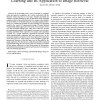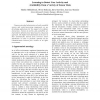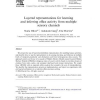2285 search results - page 89 / 457 » Active Imitation Learning |
110
click to vote
TIP
2010
14 years 8 months ago
2010
—In increasingly many cases of interest in computer vision and pattern recognition, one is often confronted with the situation where data size is very large. Usually, the labels ...
PERCOM
2004
ACM
15 years 9 months ago
2004
ACM
Using a networked infrastructure of easily available sensors and context-processing components, we are developing applications for the support of workplace interactions. Notions o...
AIED
2009
Springer
15 years 4 months ago
2009
Springer
We propose a design model for guiding learning in exploratory environments through representational choices. Selecting the appropriate representations at the correct granularity ca...
CVIU
2004
14 years 9 months ago
2004
We present the use of layered probabilistic representations for modeling human activities, and describe how we use the representation to do sensing, learning, and inference at mul...
IBPRIA
2009
Springer
15 years 2 months ago
2009
Springer
In this paper we argue that maximum expected utility is a suitable framework for modeling a broad range of decision problems arising in pattern recognition and related fields. Exa...



